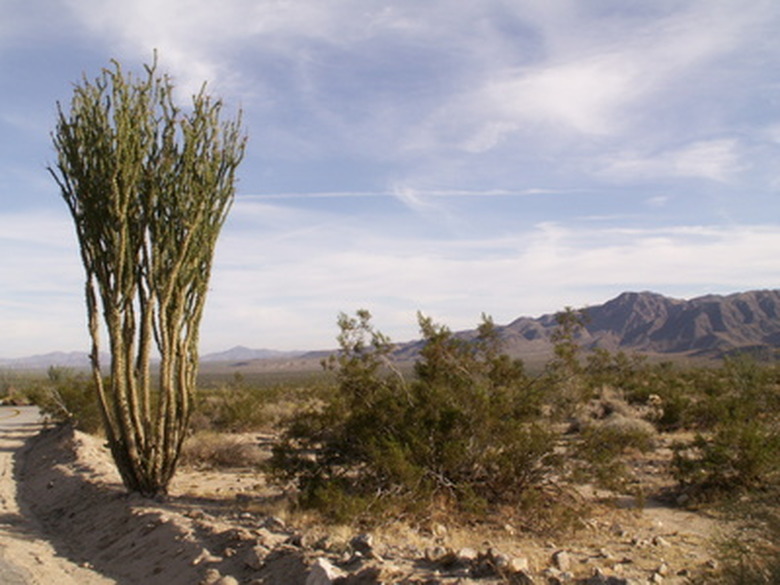Why Do Desert Plants Need Long Roots?
In the hot, dry conditions of the desert, plants need strategies to conserve water and shield themselves from intense sunlight. These strategies, which have evolved over thousands of years of living in the desert, are called adaptations. The root systems of desert plants tend to be uniquely adapted to their environment, and other plants that live in the desert have developed many innovative ways of coping with intense heat and periods of drought.
Do Cacti Have Roots?
Do Cacti Have Roots?
The cactus root system is made for surviving long periods of high temperatures and low precipitation. Deep-rooted plants, cacti have an underground structure called a taproot, which is a long, thick, tapered root that grows down straight from the base of the plant. These taproots allow cacti to access water deep below the surface of the ground. Many smaller roots grow off the central taproot, helping to keep cacti anchored and hydrated.
Other types of desert plants use another strategy for surviving low-moisture and high-temperature conditions. Instead of growing a taproot, they develop fibrous root systems that reach wide rather than deep. Mesquite is an example of a desert plant with a fibrous root system. With many branches that all originate from the base of the plant, fibrous root systems stay shallow, growing horizontally to reach far away from the plant for water and nutrients.
Some desert plants have both taproots and fibrous root systems, and use a combination of strategies to survive the harsh conditions. The structures that grow underground are just one way that desert plants have adapted to their environment.
Leaves of Desert Plants
Leaves of Desert Plants
While the root system of desert plants is adapted for absorbing water and nutrients, these underground structures have some protection from the intense heat and sunlight that aboveground structures have to survive. Subject to high winds and seldom cooled by rain, the stems and leaves of desert plants have strategies for decreasing exposure to sunlight, collecting precious moisture and reducing dehydration.
The leaves of desert plants tend to be very different from those of plant species adapted for temperate climates. While many plants that grow in the United States – such as in states like Maine and New York – have broad, fleshy leaves, plants of the desert states like Arizona and New Mexico often have leaves that are small, leathery and tough. Some species, like many cactus varieties, do not have true leaves. Instead, they grow spines or fuzz, which help protect them from sunlight and reduce moisture loss.
Some desert plants have a waxy coating on their leaves to help preserve moisture, and others are gray or gray-green instead of the bright green color of leaves in temperate zones. Leaves of desert plants may be evergreen or plants may lose leaves during the summer to conserve water. Some desert plants grow big leaves in the spring to absorb moisture, then grow smaller leaves in the summer to conserve water, an adaptation called seasonal dimorphism.
Most plants that grow in moderate climates have stomata, or pores, that open during the day to exchange carbon dioxide and oxygen. In some desert plants, stomata stay closed during the day and open at night to prevent moisture loss through evaporation.
Other Desert Plant Adaptations
Other Desert Plant Adaptations
Along with root and leaf adaptations, desert plants have many other strategies for surviving high temperatures and droughts. Some species have specialized structures for storing water, and others grow in shapes that help them collect rainwater and dew.
As an example, saguaro cacti have moisture-storing structures in their stems that allow them to reach a diameter of 24 inches and collect up to a ton of water when it rains. Other desert species have ridges or pleats that expand to store water, and some plants that grow in the desert have specialized underground structures called geophytes, which are like bulbs for storing water and food.
The aboveground features of many desert plants help them to collect and conserve water too. Beyond the fact that their leaves are often modified, the the plants are often shaped in such a way that dew and rainwater is funneled to the center of the plants, where it pools and can be absorbed by the roots of the plants.
Cite This Article
MLA
Sloane, Christina. "Why Do Desert Plants Need Long Roots?" sciencing.com, https://www.sciencing.com/why-do-desert-plants-need-long-roots-12356382/. 30 September 2021.
APA
Sloane, Christina. (2021, September 30). Why Do Desert Plants Need Long Roots?. sciencing.com. Retrieved from https://www.sciencing.com/why-do-desert-plants-need-long-roots-12356382/
Chicago
Sloane, Christina. Why Do Desert Plants Need Long Roots? last modified March 24, 2022. https://www.sciencing.com/why-do-desert-plants-need-long-roots-12356382/
